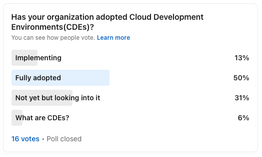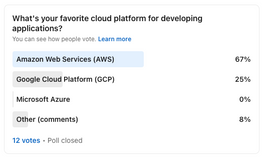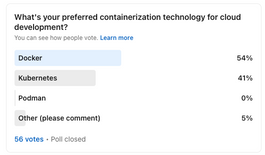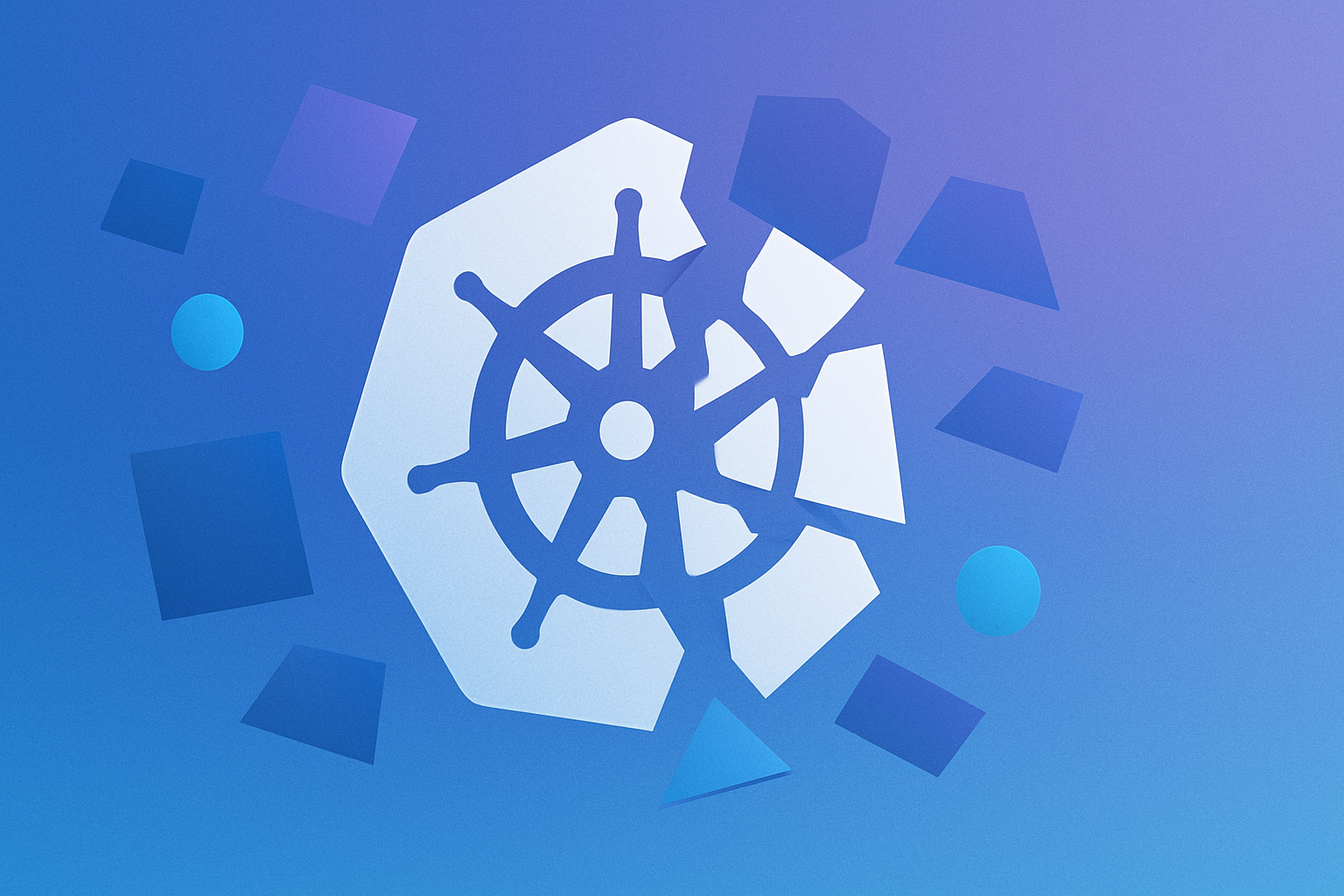Introduction #
As the popularity of cloud development continues to grow, developers are always looking for insights into the latest trends and technologies. DevZero is conducting weekly polls on LinkedIn to gather insights into the latest trends and challenges in cloud development. In February, DevZero conducted polls on topics ranging from local development challenges to cloud platform preferences and containerization technologies. The results provide valuable insights for developers interested in staying up-to-date on the latest trends in cloud development.
Analyzing the Biggest Challenges in Local Development #
Local development refers to the process of developing and testing software on a developer's local machine, as opposed to on a production server or other remote environment. It is a crucial aspect of software development that allows developers to test and debug their code before deploying it to a live environment. However, it comes with its own set of challenges.
In a recent LinkedIn poll, we asked developers about the biggest challenge they face in local development, and the results are as follows:

Environmental Consistency: The Biggest Challenge #
Looking at poll results, the majority of respondents (44%) identified environmental consistency as the biggest challenge. This is not surprising as it can be difficult to ensure that the development environment is consistent across different machines and operating systems. This inconsistency can lead to errors and bugs that can be difficult to track down and fix. To address this challenge, developers can use tools like Docker to create containerized environments that can be easily shared and replicated across different machines.
Cloud Development environments like DevZero can also help to address environmental inconsistency issues by providing standardized environments for development and testing mirroring production configuration. So if it’s working in your environment, chances are that it will work in production reducing the likelihood of errors or bugs caused by environmental inconsistencies.
Dependency Management: A Close Second #
32% of the developers who participated in the LinkedIn poll identified dependency management as the next big challenge. In software development, it can be difficult to manage dependencies and ensure that they are up-to-date and compatible with the rest of the application. Dependency management tools like Maven, Gradle, or NPM can automate this process and help developers address this challenge. The process of building, deploying, and maintaining applications can be made even more efficient and streamlined when dependency management tools are combined with cloud development environments.
Another way is to create virtual environments to isolate applications and dependencies from the underlying system. By creating a virtual environment, developers can ensure that their application has access to the necessary dependencies without interfering with other applications. Check how easy it is to create a new environment in DevZero.
Resource Constraints: A Significant Challenge #
The remaining 24% of the participating developers identified resource constraints, such as limited disk space or memory, as the biggest challenge. These constraints can make it difficult to run and test applications locally, especially if the application requires a lot of resources. To address this challenge, developers can optimize their code and use tools like memory profilers to identify memory leaks and other performance issues.
But, you don't have to be limited by the resources available on your laptop. Another way to go about this problem is to use cloud development environments.These environments can provide you with scalable, on-demand resources to help you build and deploy high-quality applications without straining your laptop. This means that you can run that yarn dev or docker run command without worrying about your laptop overheating or freezing up.
The results of this study highlight the need to address these challenges to improve developer productivity and streamline development processes locally, ultimately resulting in a better developer experience.
Cloud Development Environments: A Look at Adoption Rates in Organizations #
In recent years, Cloud Development Environments (CDEs) have become increasingly popular among software development teams. These environments provide a scalable, flexible, and cost-effective way to develop, test, and deploy applications. However, not all organizations have fully adopted this technology. In this section, we will analyze the results of a Linkedin poll that asked organizations about their adoption rates of CDEs.
We asked developers whether their organization had adopted cloud development environments (CDEs), and the results are as follows:

Half of the respondents have fully adopted CDEs, indicating that they see the benefits of this technology and have already integrated it into their development process. The 31% of respondents who are looking into it may indicate a growing interest in CDEs, and these organizations may be exploring the benefits of CDEs before deciding whether to fully adopt them. These results suggest that CDEs are becoming increasingly popular among organizations interested in improving their software development processes utilizing the cloud.
The 13% of respondents who have implemented CDEs suggest that some organizations have taken steps towards adopting this technology but may not have fully integrated it into their development process yet.
Finally, the 6% of respondents who do not know what CDEs are indicate a need for education and awareness about this technology. CDEs offer many benefits, including increased scalability, flexibility, and cost savings. However, implementing this technology can also come with some challenges. Organizations need to be aware of both the potential benefits and challenges of CDEs in order to make the best decisions about whether or not to adopt this technology.
Overall, CDEs are a cutting-edge technology that can provide organizations with significant benefits, including increased efficiency and productivity. By understanding and adopting this technology, organizations can stay competitive in today's rapidly evolving technological landscape.
Preferred Cloud Platforms for Developing Applications #
Cloud platforms have become an essential tool for developers to create, deploy, and scale applications. With multiple cloud platforms available, it can be challenging to choose the right one that fits the needs of developers. In this section, we will analyze the results of a recent poll that asked developers about their favorite cloud platform for developing applications, and the results are as follows:

Amazon Web Services (AWS) #
These results indicate that Amazon Web Services (AWS) is the most popular cloud platform among developers, with 67% of the respondents indicating it as their favorite. AWS is a comprehensive and flexible cloud platform that offers a wide range of services for developers to create, deploy, and manage applications.
Google Cloud Platform (GCP) #
The second most popular cloud platform is Google Cloud Platform (GCP), with 25% of the respondents indicating it as their favorite. GCP provides a range of services for developers to build, test, and deploy applications with ease. It offers features like auto-scaling, machine learning, and real-time data analytics, making it an attractive option for developers.
Interestingly, none of the respondents(worthwhile to note n=12) indicated Microsoft Azure as their favorite cloud platform for developing applications. Azure is a popular cloud platform that offers a range of services for developers, but it appears to have a lower adoption rate among developers.
Finally, 8% of the respondents indicated "other" as their favorite cloud platform. This suggests that some developers may be using less popular or niche cloud platforms that are not as well-known in the market.
Overall, the poll highlights the importance of cloud adoption in modern application development and the need for developers to choose the right cloud platform that meets their needs.
Preferred Containerization Technology: Docker vs Kubernetes #
Containerization has revolutionized the way developers build, deploy, and scale applications in the cloud. With multiple containerization technologies available, it can be challenging to choose the right one that fits the needs. Here, we analyze the results of a recent poll about developers’ preferred containerization technology for cloud development, and the results are as follows:

Docker #
These results indicate that Docker is the most popular containerization technology among developers, with 54% of the respondents indicating it as their preferred technology. Docker is a containerization platform that allows developers to build, package, and distribute applications in a portable and efficient way. It has become a popular choice for developers who want to simplify the process of deploying applications in the cloud.
Kubernetes #
The second most popular containerization technology is Kubernetes, with 41% of the respondents indicating it as their preferred technology. Kubernetes is an open-source container orchestration platform that automates the deployment, scaling, and management of containerized applications. It has gained popularity among developers who want to manage large-scale deployments of containerized applications in the cloud.
Other #
Interestingly, only 5% of the respondents indicated "other" as their preferred containerization technology for cloud development. This suggests that Docker and Kubernetes are the most popular containerization technologies among developers, and other containerization technologies are less widely used.
Overall, the poll highlights that containerization technologies continue to be an important aspect in modern application development. Developers should consider investing in these technologies to improve their productivity choosing the right containerization technology that meets their needs.
Conclusion #
We believe DevZero LinkedIn polls provide a valuable opportunity for developers to share their thoughts and experiences on the latest trends and challenges in software development. Results from this month indicate AWS is the most popular cloud platform among developers for developing applications, while Docker and Kubernetes are the dominant containerization technologies in the market. Developers also face significant challenges in local development, such as environmental consistency and dependency management. By addressing challenges like environmental consistency and dependency management by adopting CDEs, and investing in containerization technologies, developers can streamline their cloud development processes and improve their productivity.
To stay updated on the latest DevZero LinkedIn polls, follow us on LinkedIn and also follow our hashtag #DevZeroPollOfTheWeek. We encourage you to participate in our weekly polls, share your thoughts while learning from your peers and gaining insights. Together, we can continue to drive innovation and improve developer productivity in the cloud development industry.








